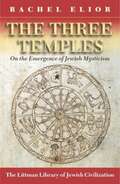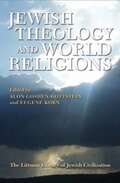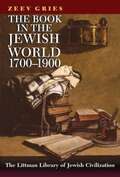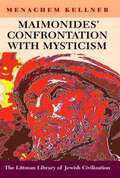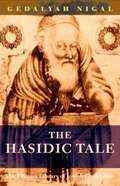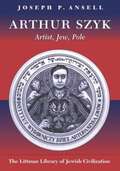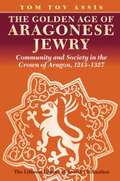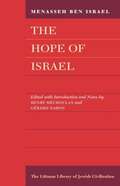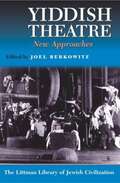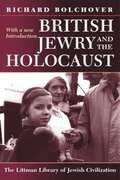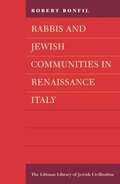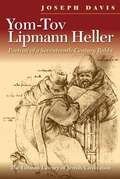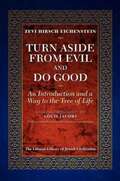- Table View
- List View
Maimonides the Rationalist (The Littman Library of Jewish Civilization)
by Herbert A. DavidsonMaimonides was not the first rabbinic scholar to take an interest in philosophy, but he was unique in being a towering figure in both areas. His law code, the Mishneh torah, stands with Rashi's commentary on the Babylonian Talmud as one of the two most intensely studied rabbinic works coming out of the Middle Ages, while his Guide of the Perplexed is the most influential and widely read Jewish philosophical work ever written. Admirers and critics have arrived at wildly divergent perceptions of the man. We have Maimonides the atheist or agnostic, Maimonides the sceptic, Maimonides the deist, Maimonides the Aristotelian, the Averroist, or proto-Kantian. We have a Maimonides seduced by the blandishments of 'accursed philosophy'; a Maimonides who sowed the seeds that led to Spanish Jews' loss of faith and mass apostasy and who was therefore responsible for the demise of Spanish Jewry; a Maimonides who incorporated philosophical elements into his rabbinic works and wrote the Guide of the Perplexed not to propagate doctrines to which he was personally committed but in order to rescue errant souls seduced by philosophy; a Maimonides who was the defender of the faith and defined the articles of Jewish belief for all time. In his own estimation, Maimonides was neither exclusively a dedicated philosopher nor exclusively a devoted rabbinist: he saw philosophy and the Written and Oral Torahs as a single, harmonious domain, and he believed that this view was similarly fundamental to the lives of the prophets and rabbis of old. In this book, Herbert Davidson examines Maimonides’ efforts to reconstitute this all-embracing, rationalist worldview that he felt had been lost during the millennium-long exile.
The Three Temples: On the Emergence of Jewish Mysticism (The Littman Library of Jewish Civilization)
by Rachel EliorIn this ground-breaking study, Rachel Elior offers a comprehensive theory of the crystallization of the early stages of the mystical tradition in Judaism based on the numerous ancient scrolls and manuscripts published in the last few decades. Her wide-ranging research, scrupulously documented, enables her to demonstrate an uninterrupted line linking the priestly traditions of the Temple, the mystical liturgical literature found in the Qumran caves and associated directly and indirectly with the Merkavah tradition of around the second and first centuries BCE, and the mystical works of the second to fifth centuries CE known as Heikhalot literature. The key factor linking all these texts, according to Professor Elior’s theory, is that many of those who wrote them were members of the priestly classes. Prevented from being able to perform the rituals of sacred service in the Temple as ordained in the biblical tradition, they channelled their religious impetus in other directions to create a new spiritual focus. The mystical tradition they developed centred first on a heavenly Chariot Throne known as the Merkavah, and later on heavenly sanctuaries known as Heikhalot. In this way the priestly class developed an alternative focus for spirituality, based on a supertemporal liturgical and ritual relationship with ministering angels in the supernal sanctuaries. This came to embrace an entire mystical world devoted to sustaining religious liturgical tradition and ritual memory in the absence of the Temple. This lyrical investigation of the origins and workings of this supernal world is sure to become a standard work in the study of early Jewish mysticism.
Jewish Theology and World Religions (The Littman Library of Jewish Civilization)
by Alon Goshen-Gottstein Eugene KornNational Jewish Book Awards Finalist for the Anthologies and Collections Award, 2012.Two of the most pervasive aspects of modern Jewish life are interaction with people of other faiths and exposure to their beliefs to a degree unknown in the past. Jewish thinking regarding other religions has not succeeded in keeping pace with the contemporary realities that regularly confront most Jews, nor has it adequately assimilated the ways in which other religions have changed their teachings about Jews and Judaism. Many Jews who grapple with Jewish tradition in the contemporary world want to know how Judaism sees today’s non-Jewish other in order to affirm itself. Re-examining Jewish tradition, they seek guidance in understanding their interfaith relationships in the light of a Jewish religious mission. Jewish Theology and World Religions advances this conversation, exploring critical issues that Jews and Jewish thought face when relating to Christianity, Islam, Buddhism, and Hinduism. It also analyses the philosophical issues raised by pluralism, non-exclusive approaches to religious truth, and appreciating the religious other. The contributors to this volume represent a range of disciplines and denominations within Judaism and share the conviction that articulating contemporary Jewish views of other world religions is an urgent objective for Judaism. Their essays show why formulating a Jewish theology of world religions is a priority for Jewish thinkers and educators concerned with reinvigorating Judaism's contribution to the contemporary world, and how it coheres with maintaining Jewish identity and continuity.
The Book in the Jewish World, 1700-1900 (The Littman Library of Jewish Civilization)
by Zeev GriesThis book offers the reader a voyage in the new world that opened up to the enlightened Jewish reader of the eighteenth and nineteenth centuries, a time when the first glimmerings of emancipation and secular education were giving large numbers of Jews their first exposure to science, literature, and art, and opening their minds to new ideas. And as on any voyage led by a knowledgeable guide, there are fascinating side-trips along the way: insights into the world of scholarship, then and now, and into the nature of knowledge. All this was happening at a time when Jews’ civil status and place in society was undergoing great change in Europe. In this seminal work, Zeev Gries shows that although the history of the book in the Jewish world has long been regarded as the province of librarians and bibliophiles, it is in fact the history of the Jewish intellect. He starts by tracing the awakening of a dormant Jewish intelligentsia—men, women, and children who were thirsty for knowledge. Books were the magic kiss that opened new doors to the modern world; within a century, Jews were making invaluable contributions to the advancement of science and of culture more generally. By surveying the literary output of those years, the author is able to discover what books were being published, where they were published and distributed, and who was reading them. He surveys the fields of halakhic literature, ethical literature, kabbalistic and mystical literature, literature for children and women, and more general literature. He talks about the role of libraries and of book reviews. Above all, he considers the role of books as agents of culture: were they guardians of hallowed sanctity or harbingers of secularization? Gries shows how the types of books favoured by the Jewish reading public offer an insight into the changing nature of their ‘portable homeland’. He then goes on to discuss the Haskalah movement and the tensions between increasing secularization and the more traditional world-view, as well as how the resurrection of Hebrew as a secular literary language contributed to the awakening of Jewish nationalism. Nevertheless, he argues that the study of literary history of the period reveals that secular and Zionist leanings were not the only trends present; Jewish literature continued to be permeated with the spirit of religion.
Maimonides' Confrontation with Mysticism (The Littman Library of Jewish Civilization)
by Menachem KellnerMany books on Maimonides have been written and still more will appear. Few present Maimonides, as Menachem Kellner does against the actual religious background that informed his many innovative and influential choices. He not only analyses the thought of the great religious thinker but contextualizes it in terms of the ‘proto-kabbalistic’ Judaism that preceded him. Kellner shows how the Judaism that Maimonides knew had come to conceptualize the world as an enchanted universe, governed by occult affinities. He shows why Maimonides rejected this and how he went about doing it. Kellner argues that Maimonides’ attempted reformation failed, the clearest proof of that being the success of the kabbalistic counter-reformation which his writings provoked. Kellner shows how Maimonides rethought Judaism in different ways. It is in highlighting this and identifying Maimonides as a religious reformer that this book makes its key contribution. Maimonides created a new Judaism, ‘disenchanted’, depersonalized, and challenging; a religion that is at the same time elitist and universalist. Kellner’s analysis also shows the deep configuration of Judaism in a new light. If, as Moshe Idel says in his Foreword, Maimonides was able to ‘reform so many aspects of rabbinic Judaism single-handedly, to enrich it by importing such dramatically different concepts, it shows that the profound structures of this religion are flexible enough to allow the emergence and success of astonishing reforms. The fact that, great as Maimonides was, he did not overcome the traditional forms of proto-kabbalism shows that the dynamic of religion is much more complex than subscribing to authorities, however widely accepted.’
The Hasidic Tale (The Littman Library of Jewish Civilization)
by Gedalyah NigalStory-telling has been an integral part of the hasidic movement from its very beginnings in the eighteenth century to the present day. Stories about the holy hasidic leaders—the tsadikim, or rebbes—and their mystical powers have been a key factor in attracting followers and maintaining their devotion. Such tales were told by the tsadikim and their followers alike. The tsadikim saw them as a way to promote the movement and justify their leadership; their followers saw them as a way to exalt their masters, cleanse them of any shred of imperfection, and defend them from every trace of criticism. No other social or religious movement in the entire course of Jewish history has engaged so intensively in the telling of stories, and nor have stories occupied such a central and important place in any other intellectual movement within Judaism. Originally published in Hebrew and expanded for this English edition by a new introduction, this book is a valuable resource for anyone interested in the history of hasidism or of Hebrew literature and the literary aspects of Jewish popular culture. It acts both as a compendium of stories by theme and as a reference work for the identification of the subject-matter, authors, editors, and editions of books that have been a popular Jewish literary genre since the second half of the eighteenth century. Hasidic tales have been reprinted many times, anthologized, and even quoted by contemporary scholars, without the identity of their authors or editors being known, and without any awareness of their background and origin. In this important work, based on analysis of all the published anthologies as well as tales scattered in a variety of obscure sources, the author traces the sources and development of the different stories. An introductory historical survey is followed by full discussions of the stories themselves, grouped by subject. Among the themes covered are matchmaking and marriages, childbirth and progeny, sickness, death and the world to come, dybbuks and the powers of evil, apostasy, and many more.
Jewish Day Schools, Jewish Communities: A Reconsideration (The Littman Library of Jewish Civilization)
by Alex Pomson Howard DeitcherAbout 350,000 Jewish children are currently enrolled in Jewish day schools, in every continent other than Antarctica. This is the first book-length consideration of life in such schools and of their relationship both to the Jewish community and to society as a whole. It provides a rich sense of how community is constructed within Jewish schools, and of how they contribute to or complicate the construction of community in the wider society. The volume reframes day-school research in three ways. First, it focuses not just on the learner in the day-school classroom but sees schools as agents of and for the community. Second, it brings a truly international perspective to the study of day schools, viewing them in relation to the socio-cultural contexts from which they emerge and where they have impact. Third, it considers day-school education in relation to insights derived from the study and practice of non-parochial education. This cross-cultural and genuinely comparative approach to the study of Jewish schooling draws on research from the United States, the former Soviet Union, South America, and Europe, making it possible to arrive at important and original insights into parochial Jewish schooling. With contributions from outstanding scholars as well as practitioners of public education and of Jewish parochial schooling, the volume reveals conflicting conceptions of the social functions of schooling and also produces original insights into the capacity of schools to build community. The book is timely in that it studies questions about faith-based schooling and the public good that today are as much questions of public policy as they are of academic inquiry. It will appeal first and foremost to those with a particular interest in Jewish schooling but will also attract the attention of academics and professionals concerned with the place of parochial education in contemporary society. Contributors: Ami Bouganim, Erik H. Cohen, Ira Dashefsky, Howard Deitcher, Jay Dewey, Joshua Elkin, Yoel Finkelman, Zvi Gitelman, Scott J. Goldberg, Ellen B. Goldring, Yossi J. Goldstein, Eli Kohn, Jeffrey S.Kress, Binyamin Krohn, Jon A. Levisohn, Ilana Maryles Sztokman, Deborah Meier, Helena Miller, Christine Muller, Michal Muszkat Barkan, Alex Pomson, Joseph Reimer, Randal Schnoor, Susan L. Shevitz, Asher Shkedi, Claire Smrekar, Uriel Ta'ir, Michael Turetsky, Rahel Wasserfall.
Founder of Hasidism: A Quest for the Historical Ba'al Shem Tov (The Littman Library of Jewish Civilization)
by Moshe RosmanThe Ba'al Shem Tov is an elusive subject for historians because documentary evidence about his life is scanty and equivocal. Until now, much of what was known about him was based on stories compiled more than a generation after his death, many of which serve more to mythologize him than to describe him. The portrait Moshe Rosman provides is drawn from life instead of from myth. Based on innovative critical analysis of familiar and previously unexplored archival sources, and concentrating on accounts that can be attributed to the Besht or to contemporary eyewitnesses, this book goes further than any previous work in uncovering the historical Ba'al Shem Tov. Additionally, documents in Polish and Hebrew discovered by Professor Rosman during his research for the book enable him to give the first detailed description of the cultural, social, economic, and political context of the Besht's life. Founder of Hasidism supplies the history behind the legend. It presents the best, most convincing description that can be drawn from the existing documentary evidence, changing our understanding of the Besht and with it the master-narrative of hasidism.A substantial new introduction considers what has changed in the study of Hasidism since the influential first edition was published, these changes being in part due to the effect of the book. New approaches, new sources, and new interpretations have been introduced, and these are reviewed and critically assessed. Criticisms of the original edition are answered and key issues reconsidered, including the authenticity of the various versions of the Holy Epistle; the ways in which Jacob Joseph of Polonne's books can be utilized as historical sources; and the relationship to history of the stories about the Ba'al Shem Tov in the hagiographical collection Shivhei Ha-Besht.
The Limits of Orthodox Theology: Maimonides' Thirteen Principles Reappraised (The Littman Library of Jewish Civilization)
by Marc B. ShapiroIt is commonly asserted that Maimonides' famous Thirteen Principles are the last word in Orthodox Jewish theology. This is a very popular notion, and is often repeated by scholars from all camps in Judaism. Yet such a position ignores the long history of Jewish theology in which Maimonides' Principles have been subject to great dispute. The book begins with a discussion of the significance of the Principles and illustrates how they assumed such a central place in traditional Judaism. Each principle is then considered in turn: the reasons underlying Maimonides' formulations are expounded and the disputes that have arisen concerning them are discussed in detail. Marc B. Shapiro's authoritative analysis makes it quite clear that the notion that Maimonides' Principles are the last word in traditional Jewish theology is a misconception, and that even Maimonides himself was not fully convinced of every aspect of his formulations. Although structured around Maimonides' Principles, this book can also be seen as an encyclopedia of traditional Jewish thought concerning the central issues of Jewish theology. The diversity of opinion in Jewish tradition on such issues as God, Creation, and the Revelation of the Torah is sure to surprise readers.
Principles of Faith (The Littman Library of Jewish Civilization)
by Isaac AbravanelMoses Maimonides was the first medieval Jewish thinker to posit a set of dogmas for Judaism, his ‘Thirteen Principles of Faith’. His statement initiated an extensive discussion among other medieval Jewish thinkers on the subject of dogma, which had an important impact on subsequent Jewish thought. The reaction to Maimonides’ innovation was complex: some scholars accepted his position without reservation; others accepted the idea that Jewish beliefs could be reduced to a creed but disagreed with Maimonides’ formulation; still others rejected the project of creed formulation in Judaism altogether. The locus classicus of this last position is the Rosh Amanah of Isaac Abranavel (1437–1508). Abravanel’s ostensible aim in writing Rosh Amanah was to defend Maimonides’ creed from the attacks of its critics, notably Hasdai Crescas and Joseph Albo, and it contains the most exhaustive and systematic analysis of the Thirteen Principles ever written. After twenty-two chapters of sustained and zealous defence of Maimonides, however, Abravanel seems to contradict himself, arguing at the end of his book that in fact Judaism has no dogmas whatsoever and that all its beliefs are equally valid, fundamental, and precious. This is the first complete English translation of Abravanel’s classic work, and includes a comprehensive introduction and notes.
The Book of Tahkemoni: Jewish Tales from Medieval Spain (The Littman Library of Jewish Civilization)
by Judah AlhariziNational Jewish Book Awards Winner of Sephardic Studies Award, 2001.The Book of Tahkemoni (The Book of Wisdom or the Heroic) is widely regarded as the crowning jewel of Hebrew maqama literature —rhymed prose interspersed with verse. In its fifty unlinked episodes we repeatedly encounter the somewhat roguish protagonist, Hever the Kenite, often disguised and assuming many and varied roles—teacher, beggar, adventurer, debater, magician, and so on. Whether preaching, spinning history or fantasy, or working a crowd, Hever the Kenite is ever a consummate story-teller and wordsmith enlightening or astounding his listeners. The author, generally considered to be the last major Hebrew poet of Spain, displays great scope, moving from prayers to tales of battlefield carnage, from philosophic reflection to droll satire targeting the pompous, the ignorant, and the mean. The whole is conveyed in a sensuous interweave of rhyme and rhythm, of literal and figurative speech, and copious biblical citations manipulated to serve unusual ends. David Simha Segal's translation captures the drama, wit, and satire of the original in a contemporary English that displays vigour and a sense of fun. Detailed annotations, printed on the same page as the text, identify the numerous allusions. Analyses of each chapter bring the reader more deeply into the text, illuminating plays on words, adroit uses of the frame tale, adaptations of Arabic and Hebrew literary conventions, and other subtleties of the original. A substantial Afterword sums up major features discussed in the analyses, especially the authorial game of hide-and-seek in the characters of the protagonist and the narrator.
Moses Mendelssohn: A Biographical Study (The Littman Library of Jewish Civilization)
by Alexander AltmannAlexander Altmann’s acclaimed, wide-ranging biography of Moses Mendelssohn (1729–96) was first published in 1973, but its stature as the definitive biography remains unquestioned. In fact, there has been no subsequent attempt at an intellectual biography of this towering and unusual figure: no other Jew so deeply rooted in the Jewish tradition was at the same time so much a part of the intellectual life of the German Enlightenment in the second half of the eighteenth century. As such, Moses Mendelssohn came to be recognized as the inaugurator of a new phase in Jewish history; all modern Jews today are in his debt. Altmann presents Moses Mendelssohn in strictly biographical terms. He does not attempt to assess his significance with the hindsight of historical perspective nor to trace his image in subsequent generations, but rather to observe his life from the period within which it was set. Altmann has written an absorbing and compelling narrative that makes a whole epoch come alive with great drama, for Mendelssohn’s life was a kaleidoscope of the European intellectual scene, Jewish and non-Jewish. As both a prominent philosopher and a believing Jew, Mendelssohn became a spokesman for the Jews and Judaism; he was one of the rare figures who become the symbol of an era. Through Altmann’s skilful use of hitherto unpublished archival material, the reader is introduced to the vast array of people—men of letters, artists, politicians, scientists, philosophers, and theologians—with whom Mendelssohn was in contact, and sometimes in conflict. What was Mendelssohn’s Judaism like? To what extent did the disparate worlds of Judaism and modern Enlightenment jostle each other in his mind and to what degree could he harmonize them? These questions are not easily answered, and it is only in the aggregate of a multitude of accounts of experiences, reaction, and statements on his part that the answer is to be found. Alexander Altmann’s analysis of this wealth of material is extraordinary in its discernment, subtlety, and clarity of expression. This masterly work will be of interest not only to those who are concerned with Jewish intellectual history but also to those interested in eighteenth-century cultural and social history, philosophy and theology, literary criticism, aesthetics, and the other areas of intellectual activity in ferment at that time. The general reader will also find much of contemporary relevance in Mendelssohn’s life, not only because of his exemplary devotion to reason and tolerance, but also because of his lifelong struggle with the basic dilemma of the Jew in the modern world: the attraction of assimilation versus the singularity of Jewish life, and the preservation of Jewish identity versus integration in the wider society.
Arthur Szyk: Artist, Jew, Pole (The Littman Library of Jewish Civilization)
by Joseph P. AnsellArtist and illustrator Arthur Szyk was a Polish Jew whose work was overwhelmingly Jewish in theme and content. In a lifetime of creativity that spanned many of the major events of the twentieth century and took him from Poland to France, England, and the United States, the mission he set himself was to use his artistic talents to serve humanity and the Jewish people. Though his politics were dictated by what he thought would be good for the Jews, his work as a political artist went well beyond a narrow definition of the Jewish cause. He is best known among Jews for his illustrated Haggadah, but the overwhelming majority of his work deals with contemporary political themes and social causes. In his native Poland, Szyk promoted the causes of freedom, toleration, and human dignity, drawing his inspiration from the Old Testament. He believed that as a Jewish artist he had a responsibility to speak for all minorities. His famous illustration of the historical Statute of Kalisz symbolized his belief that the newly re-established Polish state would welcome all its citizens into full and equal participation. Even though at that time he was already based outside Poland, he worked for many years on behalf of the Polish government in an effort to strengthen the Jews’ position. Szyk left Europe in 1940 and arrived in the United States via Canada later the same year. Determined as ever to use his art for political purposes, he crusaded against the Nazis through newspaper and magazine cartoons, posters and public exhibitions. Convinced that Hitler would not stop with the Jews but would suppress all freedom-loving people, he supported the war effort through his striking propaganda images of the German and Japanese armies, to great effect. After the war he turned his efforts to promoting the idea of a Jewish homeland in Israel. In every phase of his career, one finds Szyk looking to the past but hoping for the future; he believed that art could make a difference in the world, politically and socially. Joseph Ansell’s biography makes a singular contribution to the history of Jewish art and of Polish-Jewish relations in the first half of the twentieth century.
The Golden Age of Aragonese Jewry: Community and Society in the Crown of Aragon, 1213-1327 (The Littman Library of Jewish Civilization)
by Yom Tov AssisThe medieval Crown of Aragon reached the peak of its power and influence in the thirteenth century, and Jews took an active part in this expansion. In this detailed and meticulously researched study Yom Tov Assis deals with many important aspects of this period, which was truly a 'Golden Age' in the history of Aragonese and Catalan Jewry, both in terms of their relationship with the Crown and of their own cultural achievements. Professor Assis provides the most extensive treatment yet of Jewish self-government in the Hispanic kingdoms and the mutual interdependence of the Jewish and Christian communities. He describes institutions in very great detail, and examines the acute social problems that arose in the Jewish community and the dissent, polemics, and controversies that divided it. He shows how the proximity of the country to France and Provence on the one hand, and to Castile and Andalusia on the other, made Catalan Jewry a point of contact between Ashkenazi and Sephardi Jewry, demonstrating the effect this had on religious and cultural life, and in particular the consequences of the growing influence in Spain of Franco-German Jewry. The book is based on a very wide variety of primary sources-Jewish and non-Jewish, archival and halakhic material, notarial and royal records-in Latin, Catalan, Aragonese, and Hebrew. By drawing on these extensive sources, the author has been able to create a comprehensive description of the social, religious, and administrative aspects of Jewish life that throws much light on the wider society and economy of that period under the Crown of Aragon. The abundant detailed source notes make this an indispensable work of reference for all scholars of medieval Spanish history.
The Hope of Israel (The Littman Library of Jewish Civilization)
by Menasseh Ben-IsraelWhen The Hope of Israel was translated into English in 1652, its argument from Scripture that messianic redemption would not come to the Jewish people until they were scattered in all the corners of the Earth aroused great interest and played an instrumental part in the discussions in the Commonwealth under Cromwell which eventually led to the readmission of the Jews in 1656. This edition of that English text includes an introduction and notes which place the work in the intellectual context of its time.
Yiddish Theatre: New Approaches (The Littman Library of Jewish Civilization)
by Joel BerkowitzThis volume of essays is the first collection of scholarly studies on the Yiddish theatre to appear in English. Drawing on a variety of academic disciplines, it considers the dramatic and musical repertoire of Yiddish theatre and their historical development, popular and critical reception of productions, and the practice and consequences of state censorship. The time-span covered is broad—from the Middle Ages to the twentieth century—as is the geographical range: Cracow, London, Moscow, New York, St Petersburg, Vienna, and Warsaw. Yiddish Theatre not only presents a comprehensive study of the field but also helps illustrate the significance of the Yiddish theatre as a vital form of expression in the Jewish world. Yiddish drama and theatre has had an enormous capacity to entertain audiences on six continents, while at the same time highlighting social, political, religious, and economic concerns of vital interest to the Jewish people. Yiddish Theatre is a valuable resource for scholars, university students, and general readers interested both in Yiddish theatre specifically and related fields such as Jewish literature and culture, east European history and culture, and European and American theatre. The book contains the most comprehensive bibliography to date of sources relating to the Yiddish theatre.CONTRIBUTORS: Ahuva Belkin, Joel Berkowitz Paola Bertolone, Miroslawa M. Bulat, Brigitte Dalinger, Barbara Henry, John Klier, David Mazower, Leonard Prager, Nahma Sandrow, Nina Warnke, Seth L. Wolitz.
The History of the Jews in the Netherlands (The Littman Library of Jewish Civilization)
by J. C. H. Blom R. G. Fuks-Mansfeld I. SchöfferThis history of the Jews of the Netherlands and the role they have played in Dutch society was originally published in Dutch and widely acclaimed for the breadth of its coverage. It covers both the internal evolution of the Jewish community and its social, cultural, and economic interaction with the wider population. From the first Jewish settlements in the medieval duchies of Gelderland, Brabant, and Limburg to the Jewish community of today, the interaction between Dutch Jews and Dutch Christians has mostly been one of fruitful collaboration which only the period of German occupation from 1940 to 1945 was seriously able to disrupt. The contribution that Dutch Jews have made, and continue to make, to cultural life, to the economy, and to science is recognized as being of central importance to the Netherlands as a whole. The ten eminent scholars contributing to this book each describe Jewish life in a particular period, from the Middle Ages to the present. In doing so they consider the strains caused within the Jewish community by the effort to play a full part in Dutch society while maintaining Jewish culture, setting the discussion in the context of trends and tensions within Dutch society in the period in question. The circumstances of the Jews under German occupation and in the immediate post-war period are also discussed. The History of the Jews in the Netherlands is a definitive, indispensable work for the study of both European Jewish and Dutch history.CONTRIBUTORS J. C. H. Blom, F. Chaya Brasz, Joel J. Cahen, Renate G. Fuks-Mansfeld, Jonathan I. Israel, Yosef Kaplan, Peter Romijn, Ivo Schöffer, B. M. J. Speet, Daniel M. Swetschinski
British Jewry and the Holocaust: With a New Introduction (The Littman Library of Jewish Civilization)
by Richard BolchoverHow did British Jewry respond to the Holocaust, how prominent was it on the communal agenda, and what does this response tell us about the values, politics, and fears of the Anglo-Jewish community? This book studies the priorities of that community, and thereby seeks to analyse the attitudes and philosophies which informed actions. It paints a picture of Anglo-Jewish life and its reactions to a wide range of matters in the non-Jewish world. Richard Bolchover charts the transmission of the news of the European catastrophe and discusses the various theories regarding reactions to these exceptional circumstances. He investigates the structures and political philosophies of Anglo-Jewry during the war years and covers the reactions of Jewish political and religious leaders as well as prominent Jews acting outside the community's institutional framework. Various co-ordinated responses, political and philanthropic, are studied, as are the issues which dominated the community at that time, namely internal conflict and the fear of increased domestic antisemitism: these preoccupations inevitably affected responses to events in Europe. The latter half of the book looks at the ramifications of the community's socio-political philosophies including, most radically, Zionism, and their influence on communal reactions. This acclaimed study raises major questions about the structures and priorities of the British Jewish community. For this paperback, the author has added a new Introduction summarizing research in the field since the book's first appearance.
Rabbis and Jewish Communities in Renaissance Italy (The Littman Library of Jewish Civilization)
by Robert BonfilFocusing on the figure of the rabbi, this book provides a vivid picture of Italian Jewry during the Renaissance. The author discusses Jewish life of the period (c.1450–1600) in its social, institutional, and cultural aspects, placing them against the backdrop of the wider Catholic environment to give an original interpretation of how Jewish cultural and religious life developed in the Renaissance context. Particular attention is given to changes in the status and functions of the rabbis and to the relations between the rabbinate and the lay leadership. Of special interest is the exploration of the cultural world of the rabbis and the broader issue of intellectual developments at the time. Essentially a translation of Part I of the Hebrew edition, which won wide acclaim for its perspective, Rabbis and Jewish Communities in Renaissance Italy has been carefully adapted for an English-speaking readership. Substantial excerpts from the appendices have been incorporated into the text so that the evidence necessary to support the arguments is easily accessible.
Pride Versus Prejudice: Jewish Doctors and Lawyers in England, 1890-1990 (The Littman Library of Jewish Civilization)
by John CooperThis pioneering study is a treasure trove of new information, illustrating the lives and professional experiences of the people involved in such a way as to demonstrate clearly both the obstacles they faced and the status they achieved. Its wealth of detail, in many cases fleshing out the careers of leading Jewish professional figures for the first time, makes engaging reading. The narrative proceeds chronologically with careful attention to social context, starting with the Victorian and Edwardian eras. For the medical profession, the account of subsequent changes begins with the influx of Jews into medical schools after 1914. John Cooper goes on to describe the problems these Jewish medical students, most of them from immigrant families, encountered. Finding employment even as general practitioners was problematic, and almost insurmountable barriers confronted aspirants to consultant status. Afraid of antisemitic claims that Jews were flooding the market, the leaders of Anglo-Jewry even tried in the 1930s to dissuade young Jews from becoming doctors and lawyers. In this context, Cooper also considers the position of refugee doctors before and during the Second World War. The establishment of the National Health Service in 1948 resulted in fundamental changes, particularly in the way in which consultants were selected, and Cooper shows how this permitted Jewish doctors to enter specialties from which they had previously been excluded and to climb to the highest rungs within the medical hierarchy. He summarizes the careers of many prominent Jewish doctors. The experience of Jews in the legal profession, both as solicitors and barristers, is examined in similar detail. Cooper sets the context with a discussion of the treatment of Jewish litigants in the early years of the twentieth century in the Whitechapel County Court and the criminal courts. He shows how the persistence of an anti-Jewish bias in the inter-war period limited opportunities for Jews and dissuaded them from entering the law; he also considers the position of Jewish refugee lawyers who came to England during the 1930s and 1940s. After the war, major changes in the economy and legal system allowed Jewish law firms to expand rapidly, challenging the dominance of the City law firms in the commercial world. Many of these firms consequently began to admit Jewish partners for the first time, and Jewish barristers, hitherto confined to the less remunerative areas of civil and criminal law, were likewise able to enter the more lucrative pastures of company and tax law. From the late 1960s, Jews were also promoted in increasing numbers to position on the High Court Bench. As well as giving a detailed picture of these mainstream developments the book also looks at the careers of Jewish communist, socialist, and maverick lawyers. The story John Cooper tells will appeal not only to readers with a general interest in the subject but also to social historians. It is based on a wide range of sources, including newspapers and professional journals, archival material, law reports, and interviews conducted by the author, and there are detailed indexes of names and subjects. As well as providing an illuminating account of recent Jewish social history, the book makes a valuable contribution to the history of the medical and legal professions and to the scholarly debate as to whether or not antisemitism was of peripheral or central importance in Anglo-Jewish history.
Yom-Tov Lipmann Heller: Portrait of a Seventeenth-Century Rabbi (The Littman Library of Jewish Civilization)
by Joseph DavisThis study portrays a man and an age. Yom-Tov Lipmann Heller (1578-1654), author of the famous Mishnah commentary Tosafot yom tov, was a major talmudist, a disciple of the legendary Rabbi Judah Loew of Prague, and himself the distinguished chief rabbi of Prague and Cracow. The time in which he lived began as a ‘golden age’ for the Jews of Prague and the Jews of Poland, an age of prosperity and the rise of Jewish mysticism. During Heller’s lifetime, however, the golden age changed to darkness, and prosperity gave way to war, persecution, plague, and massacres. It was the end of the Middle Ages, the last generation before Spinoza and Shabbetai Zevi. Scholar, preacher, religious and communal leader, Heller embodied a religious and cultural ideal; he was the very model of a seventeenth-century rabbi. Born in Germany, he moved from one end of the world of Ashkenazi Jewry to the other, first to Prague, and then to Poland and the Ukraine. His life was enmeshed in a web of family ties, and bounded by complex rules of class and religion. His writing reflects not only the full heritage of medieval Jewish thought and its crystallization in the seventeenth century, but also the time and place in which he lived. In many ways, he exemplified his age, its achievements, and its limitations. Carefully researched and well written, Joseph Davis’s work is the definitive biography of Heller. He presents a richly detailed study of Heller’s worldview, his conception of Judaism, of the world around him, and of himself within it: the seventeenth century seen through seventeenth-century eyes. Heller was eyewitness to momentous, epoch-making events: the beginning of the Thirty Years’ War and the massacres of 1648. He lived through a time of tumultuous change. Texts such as the sermon in which Heller responded to the new astronomy of Brahe and Kepler, or a poem on the massacres of 1648 in which he enlarged the capacity of Hebrew poetry to express horror are significant in the larger context of Jewish and European history. Heller’s world-view was not static or motionless. His world changed greatly during his lifetime, and his views of it likewise changed greatly over the fifty years from his first writings to his last, from youth to middle age to old age. His personal circumstances also contributed to this: the experience of betrayal, arrest, imprisonment, the death of his children, and other misfortunes led him to wrestle with such questions as the differences between Jews and non-Jews and the meaning of suffering. Davis weaves these developments succinctly into a fascinating narrative that does full justice both to Heller and the momentous events he experienced.
Turn Aside from Evil and Do Good: An Introduction and a Way to the Tree of Life (The Littman Library of Jewish Civilization)
by Zevi EichensteinTurn Aside from Evil and Do Good was written by Zevi Hirsch Eichenstein (1763–1831), a hasidic master and renowned adept in Lurianic kabbalah. He wrote it with the intention of providing a guide to would-be hasidic kabbalists on how to live a holy life. Eichenstein was unusual in the hasidic world in that as well as being a kabbalist he was a competent talmudist and was also acquainted both with the science of his day and with medieval Jewish philosophy. His views differ from those of other hasidic masters, principally in the importance he attributes to studying the kabbalah, which he considers an important antidote to unbelief, and in his more positive attitude to the enjoyment of sexual activity and to business activity; he is concerned to show how both can be integrated in a holy life. This lively translation by Louis Jacobs of the second edition (1850), which includes the notes of R. Zevi Elimelekh of Dynow, gives the reader an insight into a highly unconventional hasidic master and the basic ideas of Lurianic kabbalah as he perceived them. Through hundreds of scholarly annotations, printed at the foot of each page for ease of reference, Louis Jacobs helps the reader to understand the kabbalistic ideas and imagery and other opaque terms, and clarifies the sources to which the author alludes. Turn Aside from Evil and Do Good conveys the full flavour of an original hasidic approach to kabbalism. Immensely readable, it will be of interest to anyone interested in hasidism and Jewish mysticism or the religious way and its social history. Louis Jacobs has added a very accessible introduction to explain the Lurianic system of kabbalah; he also provides biographical details of Eichenstein and his school, and a full bibliography.
The Mystical Origins of Hasidism (The Littman Library of Jewish Civilization)
by Rachel EliorThe words ‘hasid’ and ‘hasidism’ have become so familiar to people interested in the Jewish world that little thought is given to understanding exactly what hasidism is or considering its spiritual and social consequences. What, for example, are the distinguishing features of hasidism? What innovations does it embody? How did its founders see it? Why did it arouse opposition? What is the essential nature of hasidic thought? What is its spiritual essence? What does its literature consist of? What typifies its leadership? What is the secret of its persistence through the centuries? How have scholars explained its origins? Is hasidism an expression of mystical ideas, or a response to changing social circumstances? What is its connection to kabbalah? To Shabateanism? To messianism? What is its relationship to the traditional structures of authority in the Jewish world? This book aims to answer all these questions in a lucid and accessible manner. Rachel Elior focuses on the fundamental positions and the factors of primary importance: the substantial issues that recur in the hasidic texts, including how hasidim have seen themselves over the centuries, how they have constructed a new spiritual and social ideal, and how that ideal has stood the test of reality. The goal is to present the main characteristics of the hasidic movement and to examine the social implications of its mystical ideas. The text is fully supported by references to the relevant hasidic sources and academic literature. The book concludes with a list of the hasidic texts on which the discussion is based and a comprehensive bibliography of scholarly works on kabbalah and hasidism.
New Perspectives on the Haskalah (The Littman Library of Jewish Civilization)
by Shmuel Feiner David SorkinThis volume, written by a range of scholars in history and literature, offers a new understanding of one of the central cultural and ideological movements among Jews in modern times. Disengaging the Haskalah from the questions of modernization or emancipation that have hitherto dominated the scholarship, the contributors put the Haskalah under a microscope in order to restore detail and texture to the individuals, ideas, and activities that were its makers in the eighteenth and nineteenth centuries. In particular, they replace simple dichotomies with nuanced distinctions, presenting the relationship between ‘tradition’ and Haskalah as a spectrum of closely linked cultural options rather than a fateful choice between old and new or good and evil. The essays address major and minor figures; ask whether there was such an entity as an ‘early Haskalah’, or a Haskalah movement in England, look at key issues such as the relationship of the Haskalah to Orthodoxy and hasidism, and also treat such neglected subjects as the position of women. New Perspectives on the Haskalah will interest all students of modern Jewish history, literature, and culture. CONTRIBUTORS: Harris Bor, Edward Breuer, Tova Cohen, Immanuel Etkes, Shmuel Feiner, Yehuda Friedlander, David B. Ruderman, Joseph Salmon, Nancy Sinkoff, David Sorkin, Shmuel Werses.
Haskalah and History: The Emergence of a Modern Jewish Historical Consciousness (The Littman Library of Jewish Civilization)
by Shmuel FeinerShmuel Feiner's innovative book recreates the historical consciousness that fired the Haskalah—the Jewish Enlightenment movement. The proponents of this movement advocated that Jews should capture the spirit of the future and take their place in wider society, but as Jews—without denying their collective identity and without denying their past. Claiming historical legitimacy for their ideology and their vision of the future, they formulated an ethos of modernity that they projected on to the universal and the Jewish past alike. What was the image of the past that the maskilim shaped? What tactics underpinned their use of history? How did their historical awareness change and develop—from the inception of the Haskalah in Germany at the time of Mendelssohn and Wessely, through the centres of Haskalah in Austria, Galicia, and Russia, to the emergence of modern nationalism in the maskilic circles in eastern Europe in the last third of the nineteenth century? These are some of the questions raised in this fascinating exploration of an ideological approach to history which throws a searching new light on the Jewish Enlightenment movement and the emergence of Jewish historical consciousness more generally.

